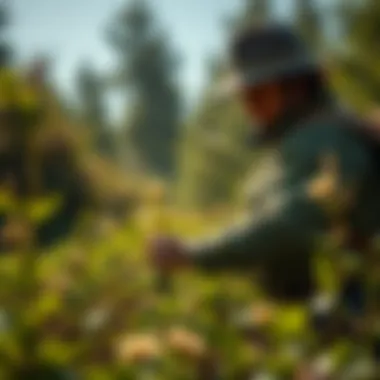Understanding Endangered Species: A Student's Guide


Overview of Research Topic
The plight of endangered species holds significant weight in today's ecological narrative. All around the world, species are slipping away, and the reasons behind this endangerment are as diverse as the creatures themselves. Factors such as habitat loss, pollution, climate change, and poaching contribute to the growing list of species that face extinction. Understanding these factors is crucial in the broader context of biodiversity, as every species plays a role in its ecosystem.
This article aims to unpack these complexities through a detailed lens. Students, educators, and nature enthusiasts are invited to explore not only the myriad causes of species endangerment but also the vital conservation strategies that aim to mitigate these threats. In doing this, we illuminate the interconnectedness of life on Earth; every extinction carries consequences that ripple across ecosystems and human communities.
Brief Background and Context
Historically, human activities have wreaked havoc on natural habitats. From deforestation to urbanization, the transformation of landscapes often sidelines the needs of countless species. For instance, when forests are bulldozed to make way for agriculture, the delicate balance of the ecosystem can falter, affecting everything from soil quality to animal behaviors. An example that illustrates this is the Sumatran orangutan, which has faced severe habitat loss due to palm oil plantations. Each case we explore will reveal not just numbers or statistics but a story featuring the species, its habitat, and the looming threats they face.
Importance in Current Scientific Landscape
The importance of preserving endangered species cannot be overstated—it binds together ecological health, economic viability, and cultural heritage. Understanding life forms that teeter on the brink is not merely an academic exercise; it drives home the point that we, as a society, share this planet and share the responsibility for its well-being. Today, scientists across disciplines are raising their voices to urge better protection measures. Conservationists push for policies that consider the ecological impact of industrial practices while educators aim to instill a sense of environmental stewardship in the next generation. The scientific community recognizes that safeguarding endangered species is fundamental to maintaining biodiversity and, ultimately, the health of our planet.
Methodology
Research Design and Approach
The exploration of endangered species is supported by a combination of qualitative and quantitative research methodologies. This approach gives a fuller picture of the issue at hand. Case studies provide depth, illustrating individual species' experiences like the narrative of the Amur leopard, while statistical analysis offers a broader view, understanding trends and forecasts of population dynamics.
Data Collection Techniques
Data collection involves a range of techniques, including field surveys, remote sensing, and interviews with experts in the field. Ecologists might make use of GPS tracking to monitor animal movements and understand habitat utilization better. Additionally, academic journals, government reports, and data from wildlife organizations contribute valuable information to create a comprehensive narrative.
As we delve deeper into the subject matter, we will sift through real-world examples, brushing alongside the threads of conservation history, drawing from the research conducted by organizations such as the World Wildlife Fund or the International Union for Conservation of Nature.
The reality is that the survival of many species rests in our hands, and understanding the cause behind their struggles is the first step to action.
Further Reading
- World Wildlife Fund
- International Union for Conservation of Nature
- National Geographic
- Wikipedia on Endangered Species
In summary, the aim is to foster meaningful engagement with the subject of endangered species, not just to educate but to inspire a collective sense of responsibility towards wildlife conservation.
Defining Endangered Species
Understanding what qualifies a species as endangered is crucial in our quest to protect biodiversity. This section serves as a foundational element, exploring the criteria that define endangerment and detailing the different categories of threatened species.
The concept of endangered species plays a pivotal role in conservation efforts. Knowing how to identify and classify species at risk can mobilize actions and resources needed to safeguard these vulnerable organisms. It also aids in raising awareness about the pressing issues that lead to species decline. Without clear definitions, efforts may be muddled, leaving critical individuals and ecosystems in jeopardy.
The Criteria for Endangerment
To determine if a species is endangered, several criteria come into play. The International Union for Conservation of Nature (IUCN) has developed specific categories based on population size, geographical range, and the rate at which the population is declining.
- Population Size: if a species has fewer than 2,500 mature individuals, it may be classified as endangered. This number isn’t arbitrary; it's grounded in research showing that small populations are more vulnerable to extinction.
- Geographical Range: species with a limited range are often on the brink. If they occupy a fragmented habitat or have a distribution less than 20,000 square kilometers, their standing may be at risk.
- Declining Numbers: a significant reduction in population over a short timeframe (usually three generations) can label a species as endangered. The rate of decline must be substantial; generally, a decrease of 50% in the past decade is alarming.
These criteria don't just serve as a checklist; they help conservationists prioritize which species to focus efforts on and allocate limited resources to.
Types of Endangered Species
Species facing the threat of extinction are categorized into three main types, which help further refine conservation efforts. Grasping these distinctions is important for any student or enthusiast engaging with conservation topics.
Critically Endangered
Species classified as critically endangered are at an extreme risk of extinction in the wild. Typically, these units demonstrate dire demographics, often comprising fewer than 250 individuals in total or showing a drastic decline in numbers.
One key characteristic of critically endangered species is their bleak outlook without immediate intervention. For instance, consider the Sumatran Orangutan, which has been in catastrophic decline due to deforestation and habitat fragmentation. Their plight illustrates the dire need for effective conservation strategies. The unique feature of this category lies in its urgency, as any delay can lead these species down an irreversible path to extinction.
The implications of focusing on critically endangered species are vast. Not only do conservation efforts save the species, but they often benefit the broader ecosystem around them. Protecting their habitat can contribute to the preservation of numerous other species sharing that environment.
Endangered


The endangered category encompasses species that are facing a serious risk but may not yet be critically close to extinction. With populations that range between 250 and 2,500 individuals, this classification represents a significant warning bell.
One species that falls under this scheme is the Asian Elephant, whose numbers have dwindled due to poaching and urban expansion. Highlighting endangered species emphasizes the critical nature of maintaining biodiversity. The unique aspect of this category is its flexibility; while an endangered species can often find itself recovering, it can also quickly fall into the critically endangered tier without protective measures.
Vulnerable
Although species labeled as vulnerable are not currently facing immediate extinction, their populations are nonetheless in decline. The common thread among vulnerable species is their sensitivity to environmental changes, which makes them more susceptible than others.
Take the Red Panda, for instance. This charming creature has seen a rise in threat levels primarily due to habitat loss and fragmentation. Their status serves as a crucial reminder that proactive measures can stave off worse consequences later.
Unique features of vulnerable species include their typically broader population numbers but also significant vulnerability to changing climates or human impact. Recognizing vulnerable species highlights the need for monitoring and long-term strategies.
Understanding the different levels of endangerment is not just academic; it equips students and enthusiasts alike with the knowledge to recognize the urgency surrounding conservation. By grasping these concepts, we can better appreciate the immense value each species represents in the intricate tapestry of life.
The Global Context of Endangerment
The phenomenon of species endangerment is not just a local or national issue, but a global crisis that necessitates immediate attention. Understanding this context is paramount when discussing endangered species. As nations around the world grapple with environmental concerns, the effects on biodiversity become clearer. This section aims to explore the broader implications of endangerment, integrating historical aspects with current data and trends. Such a comprehensive overview lays the groundwork for identifying strategies to mitigate these pressing challenges.
A Brief History of Species Extinction
Throughout history, species have faced extinction due to both natural processes and anthropogenic activities. The Earth has witnessed five significant mass extinctions, where a substantial percentage of the planet's species were wiped out. The most famous among them is the Cretaceous–Paleogene extinction event, approximately 66 million years ago, which led to the demise of the dinosaurs.
In more recent times, since humanity became more industrialized, the rate of extinction has accelerated drastically. The arrival of Homo sapiens alone marked a notable uptick in extinction rates, as habitat destruction and overhunting began to take a toll on many species. It raises a great concern: human actions have been the catalyst for numerous extinctions, such as the passenger pigeon and the Tasmanian tiger, which are now forever lost to us. The legacy of these extinctions illustrates the ongoing struggle between human advancement and nature's fragility.
Current Statistics and Trends
In understanding endangerment, statistics illuminate pressing realities
Current Extinction Rates
Currently, extinction rates are alarming. Scientists estimate that the current rate is about 100 to 1,000 times higher than the natural background rate. The IUCN Red List serves as a vital resource, providing a comprehensive status of species at risk. It reports that over 28,000 species are currently threatened with extinction. This statistic is not merely a number; it represents the unraveling of ecosystems, with key characteristics such as loss of biodiversity and ecosystem services at stake.
One unique feature of these current rates is the concentrated decline in species across particular taxa, including amphibians, mammals, and birds. This rapid decline serves as a stark reminder of our environmental legacy. Understanding these rates offers a glimpse into the urgency for conservation efforts; the longer we wait, the harder it becomes to reverse our path toward biodiversity loss.
Species at Risk
Species at risk include those categorized under various conservation statuses from vulnerable to critically endangered. The IUCN Red List, once again, is instrumental; it delineates species like the Amur leopard and the Northern white rhino as critically endangered. The presence of at-risk species highlights the key characteristic of vulnerability to habitat loss, climate change, and poaching. The intricate web of life associated with these species underscores the importance of their survival for the entire ecosystem.
Uniquely, the identification of species at risk provides an opportunity for targeted conservation strategies. It allows scientists and conservationists to prioritize efforts and utilize resources efficiently. However, the challenge comes with securing funding and political will to implement these strategies.
"The conservation of endangered species is not merely a goal but a moral obligation; it's about preserving the intricate balance of our planet."
Relevant links:
- IUCN Red List
- Wikipedia: Mass Extinction
- Britannica: Extinction
- National Geographic: The plight of endangered species
- US Fish & Wildlife Service
- World Wildlife Fund
Root Causes of Endangerment
Understanding the root causes of endangerment is pivotal for grasping the intricate web that holds ecosystems together. Each factor contributing to the decline of species interacts with others, creating a complicated cascade of effects that not only threatens the species at risk but also disrupts entire ecosystems. Acknowledging these causes isn’t merely an academic exercise; it serves as the groundwork for effective conservation strategies. When students comprehend the roots of endangerment, they can better appreciate the urgency of acting to preserve the world's biodiversity.
Habitat Destruction
Habitat destruction stands as one of the most prominent causes of species endangerment. As human populations swell and urban areas expand, natural habitats are decimated. Forests that once thrived become barren lands for agriculture or sprawling cities. Wildlife is forced into smaller, isolated patches of land, which often leads to inbreeding and a decrease in genetic diversity.
Take the Sumatran orangutan, for instance. The relentless cutting down of forests in Indonesia for palm oil plantations has decimated its habitat. While this habitat loss threatens the orangutan, it also sets off a chain reaction, affecting countless other species that share its ecosystem.
"We’re not just losing one species; we’re losing the whole fabric of the ecosystem that supports life itself."
Pollution
Pollution poses a significant threat to biodiversity. Chemicals that seep into the ground and waterways affect plants and animals—often in catastrophic ways. Pesticides, plastics, and heavy metals get caught up in the food chain, bringing harm to unsuspecting consumers. The California condor, once on the brink of extinction, suffered due to lead poisoning from ingested spent ammunition casings. The issue of pollution is not simply local; it can be global.
Key types of pollution include:


- Water Pollution: Chemicals and waste products that contaminate lakes and rivers.
- Air Pollution: Emissions from factories and vehicles that affect the health of both humans and wildlife.
- Soil Contamination: The accumulation of harmful substances in the ground.
Climate Change
Climate change is no passing fad; it’s here to stay and is reshaping ecosystems faster than many species can adapt. Changes in temperature and weather patterns can disrupt migration and breeding cycles. For example, the polar bear faces an uncertain future as melting sea ice diminishes its hunting grounds. The delicate balance of ecosystems is under threat as species struggle to adapt to shifting climatic conditions.
Impacts of climate change on species include:
- Alterations in habitat range
- Increased frequency of extreme weather events
- Shifts in food availability
Overexploitation
Overexploitation refers to the unsustainable use of natural resources. Overfishing and poaching are prominent examples, often driven by demand that far outweighs supply. The javan rhinoceros has been decimated by poaching for its horn, which, driven by myths surrounding its medicinal properties, remains highly sought after in certain cultures. When human greed exceeds the natural replenishment rate of a species, extinction looms large.
Characteristics of overexploitation include:
- Unsustainable hunting and fishing practices
- Illegal wildlife trade
- Increased pressures on populations from human consumption
Invasive Species
Invasive species are like the uninvited guests that wreak havoc on the delicate balance of native environments. They tend to outcompete, prey on, or bring diseases to native species, often leading to local extinctions. A classic example is the introduction of the Burmese python in Everglades National Park, which has severely impacted local mammal populations. Invasive species undermine the complex interactions between native flora and fauna, often displacing the very species that have existed in harmony with their ecosystem for generations.
In summary, understanding these root causes is essential for fostering awareness and inspiring action. Each factor, from habitat destruction to invasive species, plays a critical role in the decline of biodiversity. Addressing these causes head-on requires collaboration on global, regional, and local scales.
This realization encourages students and future conservationists to think critically about the human impacts on the natural world. By grasping the complexities of these issues, the hope is to inspire solutions that preserve the fragile balance of our ecosystems.
The Importance of Biodiversity
Biodiversity represents the variety of life forms on Earth, encompassing different species, genetic variation within those species, and the ecosystems in which they exist. Its importance cannot be overstated, particularly in understanding and protecting endangered species. Biodiversity brings with it a suite of benefits that play a crucial role in maintaining balance within ecosystems while also enhancing human existence in countless ways.
Ecosystem Services
Ecosystem services are the myriad benefits that humans derive from healthy ecosystems. These services can be broadly categorized into four groups:
- Provisioning Services: These include the production of food, fresh water, timber, fiber, and genetic resources.
- Regulating Services: Wetlands and forests contribute to clean air and water, pollination of crops, and climate regulation, often acting as natural buffers against environmental fluctuations.
- Cultural Services: Biodiversity has intrinsic cultural significance, providing recreational, aesthetic, and spiritual benefits.
- Supporting Services: This encompasses the processes that maintain ecosystems, such as soil formation, nutrient cycling, and primary production.
The loss of biodiversity adversely affects these services, putting not just wildlife at risk, but human survival itself. If the natural systems that provide food, clean water, and disease regulation begin to falter, everyone ends up paying the price.
Cultural and Aesthetic Value
Beyond just the biological and economic aspects, biodiversity encompasses a wealth of cultural and aesthetic values. Many cultures incorporate native species into their identity, rituals, and traditions. For instance, the intricate relationship between Indigenous peoples and their land reflects a deep understanding and respect for biodiversity. These cultural connections foster a sense of belonging and responsibility towards the environment.
Aesthetic appreciation of nature provides mental health benefits, too. Studies show that spending time in biodiverse settings can reduce stress levels and improve well-being. Imagine walking through a flourishing forest or standing in a vibrant coral reef. The sights and sounds stimulate senses and foster a connection with the natural world. Losing biodiversity means losing these unique experiences, shrouding future generations in a grey world devoid of vibrant life.
Scientific Research and Discoveries
Biodiversity is key to scientific progress and discovery. Each species represents a potential wealth of knowledge for scientists and researchers. From the development of new medicines derived from plants to understanding complex ecological interactions, biodiversity provides the raw materials for breakthroughs. For instance, the rosy periwinkle plant has played a pivotal role in treating leukemia and Hodgkin's lymphoma.
Furthermore, understanding various species helps us address pressing environmental issues. Conducting ecological research on the interactions within ecosystems can inform conservation strategies and policies. Each discovery reinforces the interconnected nature of life and success in one area may lead to gains in others, creating a positive feedback loop of knowledge and discovery.
"The whole is greater than the sum of its parts." This quote aptly describes the symbiotic relationships fostered by biodiversity, emphasizing how interconnectedness among species leads to greater resilience and adaptability in ecosystems.
Conservation Efforts
Conservation efforts are pivotal in the fight against the decline of endangered species. They encompass a broad range of strategies and actions designed to protect species and their habitats. In a world facing rapid biodiversity loss, these efforts serve as a lifeline for countless plants and animals that teeter on the brink of extinction. By focusing on the various dimensions of conservation, we can better appreciate the intricate web of life and our responsibility in its sustenance.
Protected Areas and Reserves
Protected areas play a crucial role in conserving endangered species by providing safe havens where wildlife can thrive without human interference. National parks, wildlife reserves, and marine protected areas form the backbone of biodiversity conservation strategies.
- These sanctuaries not only protect critical habitats but also support ecosystems that benefit the surrounding community.
- They act as a refuge for endangered species, allowing populations to recover and regain their numbers.
However, it’s essential to recognize that not all protected areas are created equal. The design, management, and enforcement of regulations within these areas can greatly affect their effectiveness. For example, certain reserves might face encroachments from agriculture or urban development, hindering their potential to serve as true sanctuaries.


Legal Frameworks and Policies
Legislation also plays an important role in conservation. Laws and international treaties provide the necessary framework for protecting endangered species and their habitats.
The Endangered Species Act
The Endangered Species Act (ESA) is a cornerstone of wildlife conservation in the United States. Enacted in 1973, the act aims to prevent the extinction of imperiled species and to recover populations. A unique feature of the ESA is its ability to designate critical habitats for endangered species, ensuring these areas receive the protection they need. This act has helped save iconic species, such as the American bald eagle and the gray wolf, significantly contributing to their population rebounds.
Moreover, it serves as a model for similar laws in other countries, highlighting its effectiveness. However, the ESA is not without its challenges. It can lead to conflicting interests between conservation goals and economic development, often drawing public scrutiny and debate. Yet, its continued relevance showcases its importance in efforts to protect our planet’s diverse wildlife.
International Treaties
International treaties are also significant in the global context of conservation. Agreements like the Convention on International Trade in Endangered Species of Wild Fauna and Flora (CITES) regulate trade to ensure that species are not overexploited. A key characteristic of these treaties is that they establish legal frameworks that countries must adhere to, fostering collaboration among nations.
The unique feature of this cooperative approach is that it allows for a shared responsibility in species conservation, pooling resources and knowledge from different countries. However, the enforcement of these agreements can be tricky, as compliance varies from one nation to another, creating loopholes that can undermine their effectiveness.
Community Involvement in Conservation
Community involvement is at the heart of successful conservation. Engaging local populations not only helps to secure the support needed for conservation initiatives but can also empower communities. This can lead to sustainable practices that align with both the economic interests of the locals and the conservation of their natural resources. Grassroots movements often serve as the driving force behind many successful conservation strategies, reminding us that the fight for biodiversity is a shared journey.
Case Studies of Endangered Species
Case studies serve as pivotal elements in understanding the pressing reality of endangered species. They provide concrete examples that illustrate the myriad challenges these species face and the multidimensional approach required for their conservation. By examining specific species, students and educators can draw connections between ecological, social, and economic factors that contribute to endangerment. Moreover, case studies enhance critical thinking, as they compel individuals to analyze the effectiveness of conservation strategies and engage with real-world scenarios.
In essence, these narratives highlight not just the plight of individual species but also the broader implications on biodiversity and ecosystem stability.
The Amur Leopard
The Amur leopard, native to the temperate forests of the Russian Far East and northeastern China, stands out as one of the most endangered large cats in the world. With an estimated population of fewer than 100 individuals, this majestic creature serves as a stark example of the consequences of habitat loss, poaching, and human encroachment. The Amur leopard's survival hinges on the preservation of its forest habitat which is rapidly diminishing due to logging and agriculture.
Critical actions have been taken to protect this elusive feline. For instance, the creation of the Land of the Leopard National Park was established in 2012 in Russia, offering a protected sanctuary. These efforts underline the importance of habitat preservation while also engaging local communities in conservation practices. It's a real testament to how collaborative efforts can yield positive results.
"Protecting the Amur leopard is not just about saving the species; it's about preserving an entire ecosystem that relies on its presence."
The Northern White Rhino
The Northern white rhino faces an unprecedented crisis; only two individuals are left on the planet, both of which are female. This stark reality paints a sorrowful picture of what happens when relentless poaching for ivory and habitat loss take center stage. To date, despite conservationists' efforts, the northern white rhino teeters on the brink of extinction, prompting a shift in approach to conservation.
Innovative methods are now under consideration, including advanced reproductive technologies. Scientists are exploring options like in vitro fertilization to preserve the genetic material of the last remaining rhinos, in hopes of one day reviving the population. This case study illustrates the intersection of science and conservation strategies and raises crucial questions about the ethics of such interventions.
Notably, the story of the northern white rhino is not just one of despair, but also of urgent action and hope. It serves as a stark reminder of human impact on wildlife and the critical need for continued advocacy.
The Vaquita
The Vaquita, a small porpoise found in the Gulf of California, is the most endangered marine mammal, with fewer than 30 individuals remaining. It faces extinction due to gillnet fishing used illegally to catch another endangered species, the totoaba fish, whose swim bladders are prized in traditional Chinese medicine. The plight of the Vaquita exposes the complications of conservation intersecting with economic activities.
Efforts to save the Vaquita have included banning gillnet fishing in its habitat and implementing strict monitoring. However, enforcement remains a pressing issue.
As part of the Vaquita Protection Initiative, conservationists are exploring the potential of technological interventions, including acoustic monitoring systems, to track the remaining population in real-time. This case underscores the importance of combining innovative technology with grassroots tactics to foster sustainable coexistence between human needs and wildlife conservation.
In summary, these case studies bring to light the urgency of conservation efforts and the complexities involved. They inspire a new generation of thinkers and doers, ready to grapple with the challenges ahead. Studying these endangered species enables students to recognize their role in the ecosystem and fosters a sense of responsibility toward taking action.
Technological Advancements in Conservation
Advancements in technology are playing a crucial role in conservation efforts around the globe. With challenges such as habitat loss, poaching, and climate change, new tools and methods are emerging that aid in the protection of endangered species. Understanding how these technologies operate, their benefits, and potential downsides is essential for students, researchers, educators, and professionals invested in biodiversity preservation. Let's delve into some specific advancements that are reshaping conservation strategies.
Remote Sensing and GIS
Remote sensing and Geographic Information Systems (GIS) are powerful tools in the arsenal of conservationists. Remote sensing involves acquiring data about the Earth's surface using satellites or aircraft. This technology allows researchers to monitor habitat changes, assess land use, and track wildlife migration patterns from a distance.
GIS, on the other hand, enables the visualization of data related to geography. It can aid in delineating protected areas, identifying critical habitats, and even predicting future land-use scenarios. These technologies are beneficial for several reasons:
- Data Collection: Researchers can gather extensive amounts of data rapidly.
- Monitoring: Consequences of environmental changes can be observed over time.
- Strategic Planning: Conservation strategies can be better developed using accurate geographic data.
Effects of Remote Sensing and GIS
- Improve response time to environmental threats.
- Enable policymakers to make informed decisions regarding land protections.



